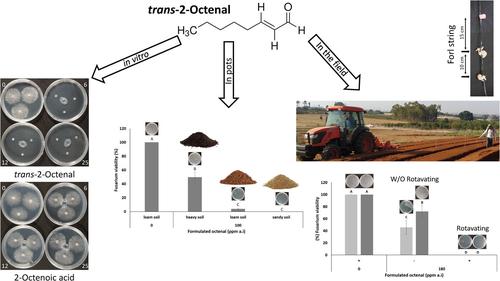当前位置:
X-MOL 学术
›
Pest Manag. Sci.
›
论文详情
Our official English website, www.x-mol.net, welcomes your
feedback! (Note: you will need to create a separate account there.)
trans‐2‐Octenal controls Fusarium oxysporum f. sp. lycopersici, the causal agent of tomato wilt in vitro, in soil and in the field
Pest Management Science ( IF 3.8 ) Pub Date : 2025-01-16 , DOI: 10.1002/ps.8648
Orna Liarzi, Ma'ayan Golani, Amnon Magnus, Ganit Levi‐Ruso, Ariel Ewenson, Yuval Benyamini, David Ezra
Pest Management Science ( IF 3.8 ) Pub Date : 2025-01-16 , DOI: 10.1002/ps.8648
Orna Liarzi, Ma'ayan Golani, Amnon Magnus, Ganit Levi‐Ruso, Ariel Ewenson, Yuval Benyamini, David Ezra

|
BACKGROUNDFungal plant diseases cause major crop losses. Phytopathogenic fungi's ability to evolve resistance to fungicides, alongside ongoing prohibition of such agents by the European Commission because of their pronounced adverse effects on human health and the environment, make their control a challenge. Moreover, the development of less perilous fungicides is a complex task. Here we describe the process and challenges involved in the development of a novel fungicide, from in‐vitro studies to field experiments.RESULTSIn‐vitro experiments with trans ‐2‐octenal, a bioactive compound secreted by the endophytic fungus Daldinia cf. concentrica , revealed its ability to fully inhibit and kill phytopathogenic microorganisms. A formulated version of trans ‐2‐octenal was then used against the soil‐borne pathogen Fusarium oxysporum f. sp. lycopersici (Forl), the causal agent of tomato vascular wilt disease, in pot experiments with different soil types. We found the highest fungicidal activity in sandy and loam soils, whereas heavy soil impaired activity. Lastly, we investigated the activity of the formulated trans ‐2‐octenal against Forl in semi‐field experiments. We achieved complete elimination of Forl, provided the soil is rotavated after trans ‐2‐octenal application.CONCLUSIONtrans ‐2‐Octenal has the potential to control Forl in vitro , in pots and in the field. © 2025 Society of Chemical Industry.
中文翻译:

反式 2-辛烯控制尖孢镰刀菌 f. sp. lycopersici,番茄枯萎病在体外、土壤和田间的致病剂
背景 真菌植物病害造成重大作物损失。植物病原真菌对杀菌剂产生抗性的能力,以及欧盟委员会因其对人类健康和环境的明显不利影响而不断禁止此类药物,使它们的控制成为一项挑战。此外,开发危险性较小的杀菌剂是一项复杂的任务。在这里,我们描述了从体外研究到田间实验的新型杀菌剂开发所涉及的过程和挑战。结果反式 2-辛烯醛(一种由内生真菌 Daldinia cf. concenrica 分泌的生物活性化合物)的体外实验揭示了其完全抑制和杀死植物病原微生物的能力。然后在不同土壤类型的盆栽实验中,使用反式 2-辛烯醛的配方版本对抗土壤传播的病原体尖孢镰刀菌 f. sp. lycopersici (Forl),番茄维管束枯萎病的病原体。我们发现沙质和壤土的杀菌活性最高,而重土壤则损害了活性。最后,我们在半场实验中研究了配制的反式 2-辛烯醛对 Forl 的活性。我们实现了 Forl 的完全消除,前提是土壤在反式 2-辛烯施用后被旋转。结论反式 2-辛烯醛具有在体外、花盆和田间控制 Forl 的潜力。© 2025 化工学会.
更新日期:2025-01-16
中文翻译:

反式 2-辛烯控制尖孢镰刀菌 f. sp. lycopersici,番茄枯萎病在体外、土壤和田间的致病剂
背景 真菌植物病害造成重大作物损失。植物病原真菌对杀菌剂产生抗性的能力,以及欧盟委员会因其对人类健康和环境的明显不利影响而不断禁止此类药物,使它们的控制成为一项挑战。此外,开发危险性较小的杀菌剂是一项复杂的任务。在这里,我们描述了从体外研究到田间实验的新型杀菌剂开发所涉及的过程和挑战。结果反式 2-辛烯醛(一种由内生真菌 Daldinia cf. concenrica 分泌的生物活性化合物)的体外实验揭示了其完全抑制和杀死植物病原微生物的能力。然后在不同土壤类型的盆栽实验中,使用反式 2-辛烯醛的配方版本对抗土壤传播的病原体尖孢镰刀菌 f. sp. lycopersici (Forl),番茄维管束枯萎病的病原体。我们发现沙质和壤土的杀菌活性最高,而重土壤则损害了活性。最后,我们在半场实验中研究了配制的反式 2-辛烯醛对 Forl 的活性。我们实现了 Forl 的完全消除,前提是土壤在反式 2-辛烯施用后被旋转。结论反式 2-辛烯醛具有在体外、花盆和田间控制 Forl 的潜力。© 2025 化工学会.































 京公网安备 11010802027423号
京公网安备 11010802027423号